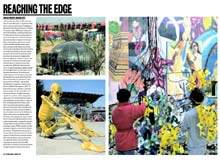Only by flying into São Paulo can you truly comprehend its scale. Just when you think you’ve seen it all, another sprawling mass of orange-roofed houses comes into view, punctuated by clusters of office blocks and luxury apartment complexes. The city is packed solid with infrastructure on a tangled network of roads, chaotically thrown together during one of the fastest periods of urban expansion ever seen.
Between 1900 and 2000, São Paulo grew by 7,200%. Although this rate is slowing, as industrial production becomes more evenly distributed, the São Paulo metropolitan area today has just under 20 million inhabitants, making it the seventh-largest city on Earth.
This explosive rate of growth has brought a catalogue of problems. Levels of poverty and crime remain high, and industrial pollution contaminates the city’s air and rivers. Poor public transportation has pushed locals onto the famously congested roads, with the total number of automobiles rising to a barely sustainable seven million in early 2011.
Although magnified by the sheer size of São Paulo, these problems are hardly unique in a country that saw such large-scale urban migration that many important questions about urbanism did not have time to be asked.
Anything can happen
For the architect, few situations could be more daunting, though that’s not what you’d think from speaking to Rafael Brych and Alexandre Hepner. They are two of the founding partners of Arkiz, the youngest of seven architecture practices to receive a São Paulo New Practices award, which is given to those seen as representing the new generation of Brazilian architecture. Both men exude an infectious sense of possibility.
“It’s an amazing time to be an emerging practice,” says Brych. “There is a lot to do in terms of infrastructure, educational and cultural public spaces, public housing… everything needs to be done.
How well do you really know your competitors?
Access the most comprehensive Company Profiles on the market, powered by GlobalData. Save hours of research. Gain competitive edge.

Thank you!
Your download email will arrive shortly
Not ready to buy yet? Download a free sample
We are confident about the unique quality of our Company Profiles. However, we want you to make the most beneficial decision for your business, so we offer a free sample that you can download by submitting the below form
By GlobalData“But there is a new way of thinking to how it was even ten years ago. People often say, ‘this is Brazil’s time’. Maybe this time it really is.”
Arkiz’s approach is a departure from the modernism that has come to define Brazil, a fact that shines an ironic spotlight on our meeting place – London’s brutalist Barbican Centre. While clearly appreciative of Niemeyer and those he inspired, Arkiz is trying to bring a more fluid, programme-specific approach to its work. This represents a missing step, which in other parts of the world was taken 30 years ago.
“Theoretically, Brazil didn’t have a postmodern phase, but went straight through to contemporary,” says Hepner. “We ended up with architecture void of any ideology except for that of accumulation. We are trying to understand communication through architecture and the symbolic values it can embody, not just the language of formalism that has always been the spirit of Brazilian architecture.”
The period between the end of Brazil’s golden age of modernism and today, around 30 years, has been hugely regressive. Many did not see how postmodernist ideas could be applied to the Brazilian context and, in Hepner’s opinion, dismissed them as ‘European frivolity’. The country’s cities grew quickly and in a disorderly fashion, a situation exacerbated by a prolonged period of economic volatility that saw inflation rates reach as high as 6,821% in April 1990.
“The modernist golden age was sponsored by the state,” Hepner explains. “When the economy went bad and the state decided to withdraw its support, a gap was left. Architects were trying to make it work, but weren’t having the clients they were used to. And when $1,000 today is going to be worthless tomorrow, people are reluctant to invest. Over the last ten years, however, because of the shift in Brazil’s economy and the stabilisation of the currency, it has become a new time for architecture.”
Social integration
A stronger economy has made many people very wealthy, while allowing the government to implement social programmes that drag millions out of poverty. But there is still a big material and physical divide between rich and poor that Brazilian architects find cannot be ignored. The partners from Arkiz view public spaces as the best way to encourage social integration, as demonstrated by a recent proposal.
The Olympic Port, a complex in the run-down old harbour area of Rio de Janeiro, will house the media and referees at the 2016 Olympic Games, and eventually contain such facilities as a conference centre, a hotel and apartments.
Arkiz’s design features multistorey buildings combined with pedestrianised squares and concourses, creating harmonious social space in a densely urban context.
“For the Rio Olympics, the state is trying to copy what Barcelona did – building sports facilities as a way of regenerating certain parts of the city,” says Brych. “It at least shows that the government is beginning to take notice of how architecture can help bring about social change, even if there is a long way to go before we catch up with Europe.”
Another São Paulo architect, Milton Braga of MMBB, is working with public spaces, if on a more localised scale. He sees areas of interaction as integral to good urbanism, but believes that places like São Paulo are at an inherent disadvantage to Rio de Janeiro. The latter has beaches, which modulate the urban fabric and create a focal point for leisure and social interaction. MMBB is involved in a project in the favela of Paraisopolis that is harnessing Brazilian beach culture and bringing it inland.
A heavily polluted river runs through the favola. Braga’s team has designed a system that creates a double river, leaving unpolluted water above ground and pushing waste water into an underground piping system. This will create a pleasant point of focus for local residents, and will help contain the effects of regular flooding. Building a public space around the newly clean river should help reinforce its own value. This is vital when building in some of the poorest, most badly planned areas of a city.
“In favelas, you have to make unoccupied space resistant to occupation,” Braga says. “If people don’t understand the value of space, they invade it. I think water can help in this way – not just in terms of beauty but also play. We don’t have abundant nature here to modulate the urban tissue. Infrastructural systems could help make up for this.”
Braga is pleased with the progress being made by Brazil’s architects. He believes, though, that governance issues often lead to good plans remaining unfulfilled. Public departments end up working against each other, and realpolitik plays a much greater role than it should.
“In Brazilian cities, actions must be integrated,” he explains. “When you intervene to improve mobility, you also consider public spaces and the construction of facilities.
Projects here are often too sector-specific and you end up with different government agencies carrying out contradictory actions. Continuity is also a problem. When a new administration comes in, they often get rid of everything that was prepared by the previous one and start over again. If you attack your opponent, it can reflect favourably on you. It’s a very poor kind of politics.”
True value
Both architects agree that trying to create something grandiose or iconic is not the answer to Brazil’s urban design questions. In such dense, chaotic environments, small, site-specific ideas are those with true value.
“Urban identity is not something you can engineer, as some have tried to do,” says Hepner. “It comes from little things – the corner shop, small talk in the neighbourhood… We don’t need our cities to be good for tourists; we just need them to be good places to live in.”
The problems facing Brazil’s cities are not unique; other fast-growing urban centres such as Shanghai and Mumbai are in a similar position. But, unlike the inhabitants of those cities, Brazilians have experienced decades of urban living, made a lot of mistakes and accrued a wealth of experience. By combining this knowledge with a culturally specific, socially aware approach to architecture, the country could be an example for all to follow.
This article was first published in our sister publication The LEAF Review.





